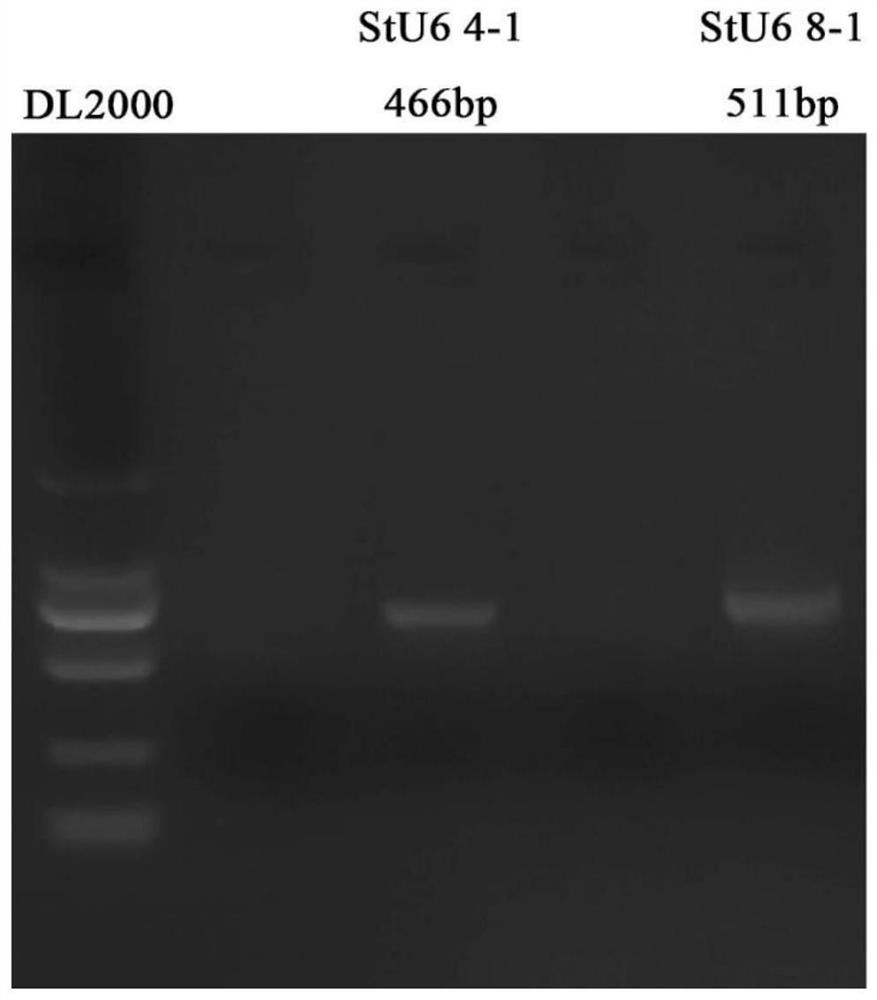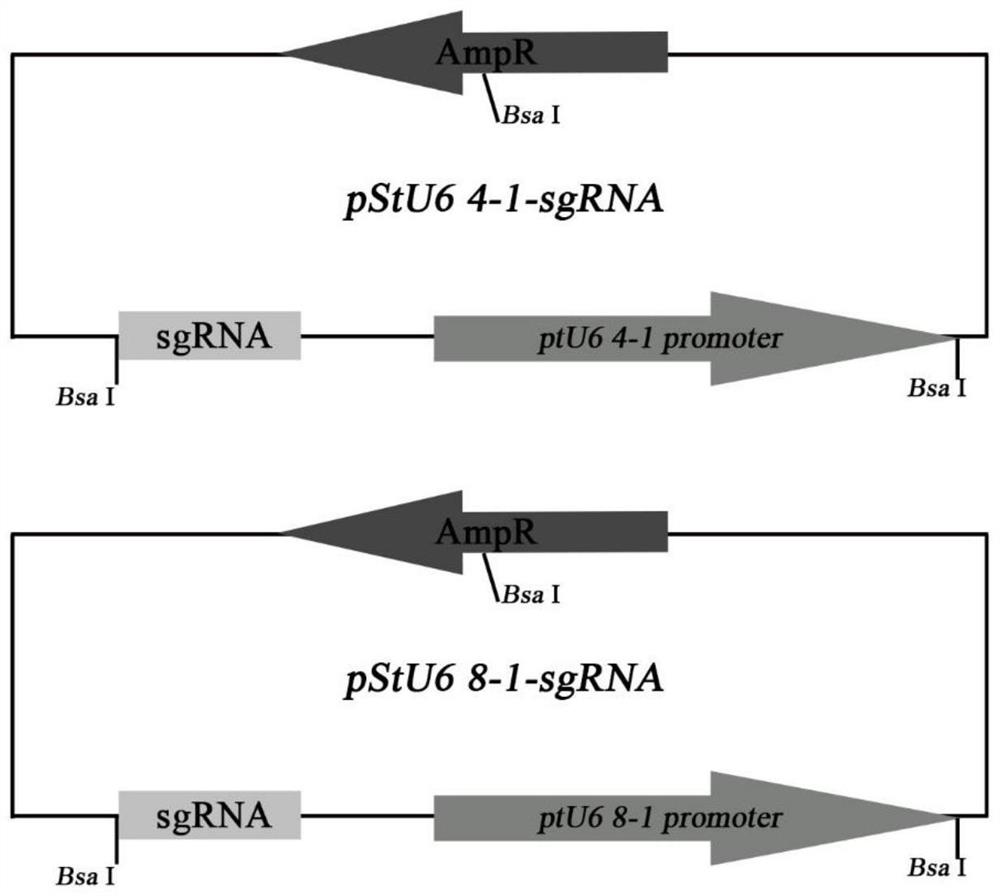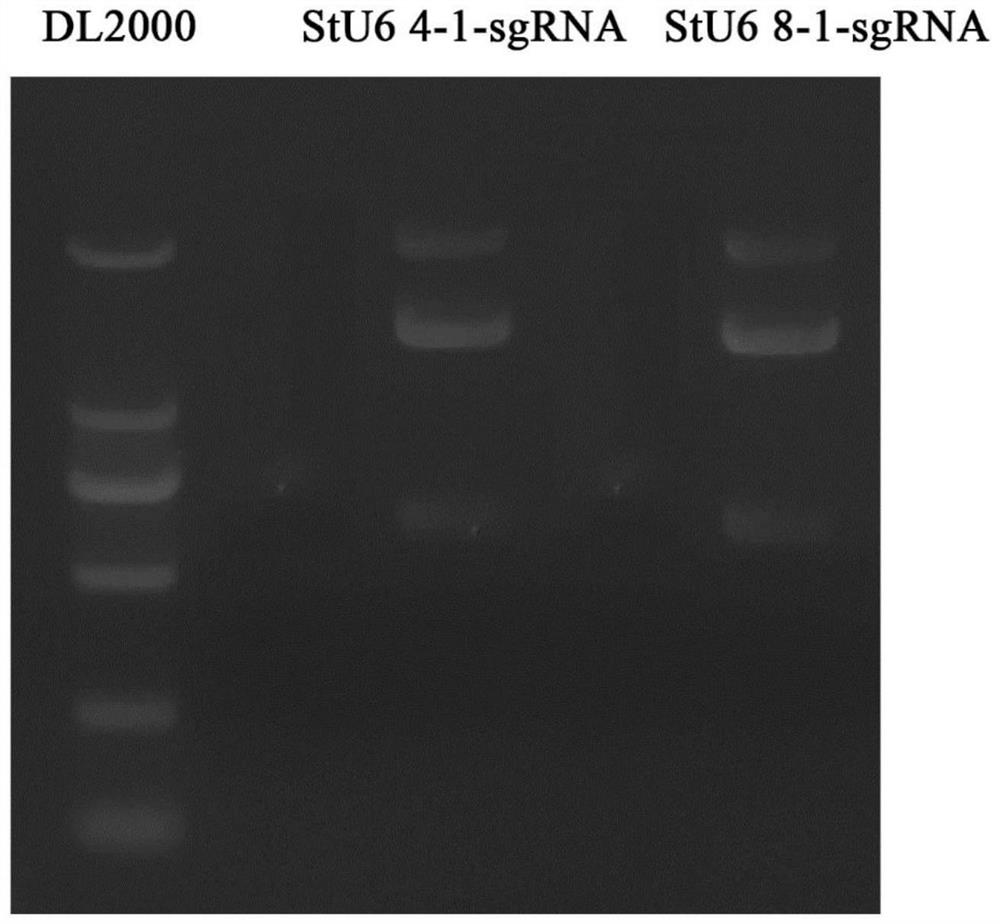Potato U6 RNA polymerase III type promoter and cloning and application thereof
A potato and promoter technology, applied in the field of genetic engineering, can solve the problems of limiting the application of potato gene editing technology, lack of potato U6 promoter and the like
- Summary
- Abstract
- Description
- Claims
- Application Information
AI Technical Summary
Problems solved by technology
Method used
Image
Examples
Embodiment 1
[0045] The specific steps for obtaining two kinds of U6 gene promoters StU6 4-1 and StU6 8-1 in potato are as follows:
[0046] 1. Use Arabidopsis thaliana AtU6-1 gene sequence to perform BlastN comparison in the potato genome database (http: / / spuddb.uga.edu / dm_v6_1_download.sht-ml) to find out the typical U6 gene sequence in potato. There are only 3 SNP differences between the typical potato U6 gene sequence and the Arabidopsis AtU6-1 gene sequence, indicating that the U6 gene sequence is relatively conserved between potato and Arabidopsis. Both the potato U6 gene promoter sequence and the Arabidopsis AtU6-1 gene promoter sequence have two typical cis-acting elements, TATA box and USE motif. Finally, StU6 4-1 and StU6 8-1 promoters were selected for cloning.
[0047] 2. Design primers in the StU6 4-1 and StU6 8-1 promoter reference sequences for sequence cloning.
[0048] The following primers were designed for the StU6 4-1 promoter clone:
[0049] StU6 4-1pF: GGGCTTCACTGT...
Embodiment 2
[0056] The construction of potato StU6 4-1-sgRNA and StU6 8-1-sgRNA expression cassette vectors, its specific steps are as follows:
[0057] 1. Using the 466 bp StU6 4-1 gene promoter fragment shown in SEQ ID No: 1 and the 511 bp StU6 8-1 gene promoter fragment shown in SEQ ID No: 2 as templates, design the following homology arms containing The primers were used for PCR amplification of the StU6 4-1 gene promoter and the StU6 8-1 gene promoter respectively:
[0058] StU6 4-1gF: GTGGAATCGGCAGCAAAGGAGGGCTTCACTGTGAATTTAG;
[0059] StU6 4-1gR: TGTTATTCTTCAGAGGTCTCTCAAACACATATGTTGTTGTTGA;
[0060] StU6 8-1gF: GTGGAATCGGCAGCAAAGGAAATTGACGGGTAGACATCA;
[0061] StU6 8-1gR: TGTTATTCTTCAGAGGTCTCTCAGACATAGGTTAATGTTTTG;
[0062] 2. Perform PCR amplification with high-fidelity enzyme PhantaR Max. The PCR reaction volume was 25 μL. The PCR reaction program was 95°C for 3 min; 30 cycles of 95°C for 30 s, 52°C for 30 s, 72°C for 30 s, and then 72°C for 5 min; the resulting PCR product w...
Embodiment 3
[0070] The specific steps for the construction of the NbPDS gene editing vector of Nicotiana benthamiana and the mutation of the NbPDS gene sequence are as follows:
[0071] 1. NbPDS gene editing target site design and target linker preparation
[0072] According to the NbPDS gene sequence of Nicotiana benthamiana, TACGAGAACTGCAGTCCACG was selected as the target site sequence, and the target linker primer pair was designed according to the sequence:
[0073] The following primer pairs were designed for the target linked to the StU6 4-1 promoter:
[0074] NbPDS-4-F: TTTGTACGAGAACTGCAGTCCACG;
[0075] NbPDS-4-R: AAACCGTGGACTGCAGTTCTCGTA;
[0076] Design the following primer pairs for the target linked to the StU6 8-1 promoter:
[0077] NbPDS-8-F: TCTGTACGAGAACTGCAGTCCACG;
[0078] NbPDS-8-R: AAACCGTGGACTGCAGTTCTCGTA;
[0079] Dissolve the above adapter primers into a 100 μM stock solution, add 1 μL of each paired primer to 98 μL 0.5×TE, mix and dilute to 1 μM. 90°C for 30 ...
PUM
 Login to View More
Login to View More Abstract
Description
Claims
Application Information
 Login to View More
Login to View More - R&D
- Intellectual Property
- Life Sciences
- Materials
- Tech Scout
- Unparalleled Data Quality
- Higher Quality Content
- 60% Fewer Hallucinations
Browse by: Latest US Patents, China's latest patents, Technical Efficacy Thesaurus, Application Domain, Technology Topic, Popular Technical Reports.
© 2025 PatSnap. All rights reserved.Legal|Privacy policy|Modern Slavery Act Transparency Statement|Sitemap|About US| Contact US: help@patsnap.com



